Life and Work as One Big Project: Interview with Artist and COAST Projects Founder, Billy Kearins
This week’s interview is with Billy Kearins, an artist and owner of COAST Projects, a Key West based lifestyle brand. There felt like no better way to do the description of COAST justice than to borrow Billy’s words from the website:
“Through a half decade of refinements and realizations COAST transitioned from the fringes of Front Street, Stock Island to the historic Bahama Village neighborhood of Old Town, Key West, slowly evolving into a curated lifestyle brand — offering classic designs, printed by hand on the fabled front porch of the Whitehead Street Outpost. All the while, the crew remained true to their ragtag origins — pulling off raucous last-minute concerts at obscure venues and bringing a raw but sharpened edge to radical collaborations with like minds from coast to coast.”
As a native Floridian, I’ve always been fascinated by the unique culture that has defined Key West. I was eager to learn more about someone who’s built their life and career there, as well as worn many different hats over the years as an entrepreneur, captain, boat builder, graphic designer, and now artist.
I wanted to know: How has Billy learned to embrace change and uncertainty? To continually seek out evolution and the next thing? What led him to finally embrace the title of artist? What’s allowed him to lean into a different rhythm of working and taking time to recharge? What’s next for him?
We spoke about all of that and covered the history of what led to the modern-day version of COAST. I’ll let Billy’s words take it from here.
Note: The following interview has been lightly edited for clarity and length. While every effort has been made to preserve the integrity of the conversation, please be aware that the quotes may not be verbatim but reflect the essence of the dialogue.
Let’s start with a few rapid-fire questions to set the scene.
Where do you live? I live and work in the Bahama Village neighborhood of Old Town, Key West.
How would you describe your occupation? This is a hard one. I wrote a whole blog post about this, but I’ve been starting to get more comfortable saying I’m an artist. It’s broad, but it tells a little about me. I used to say I owned a business or am a graphic designer. But now, I think artist is the easiest one-word answer.
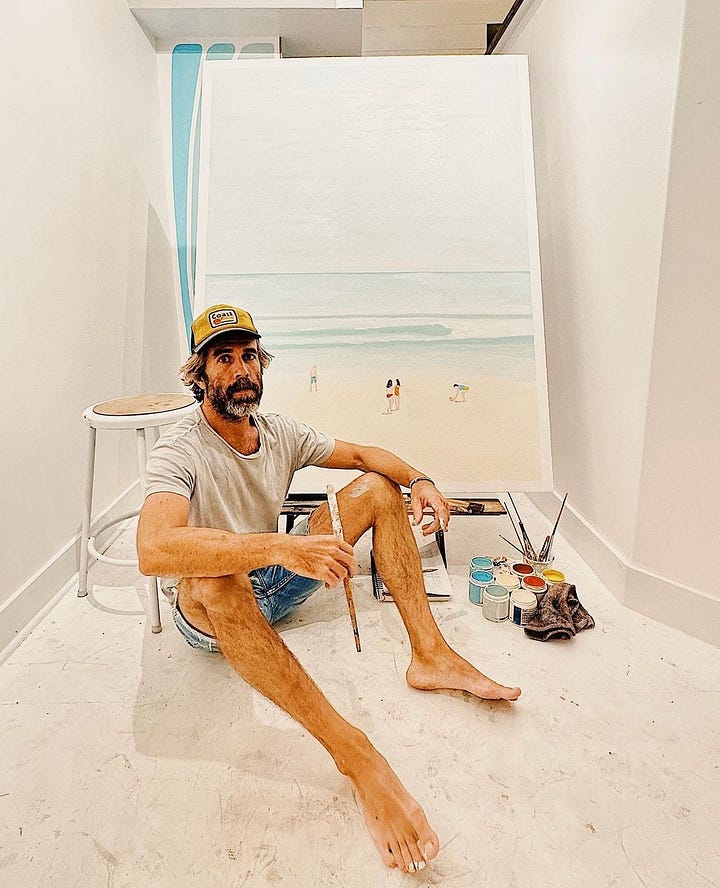
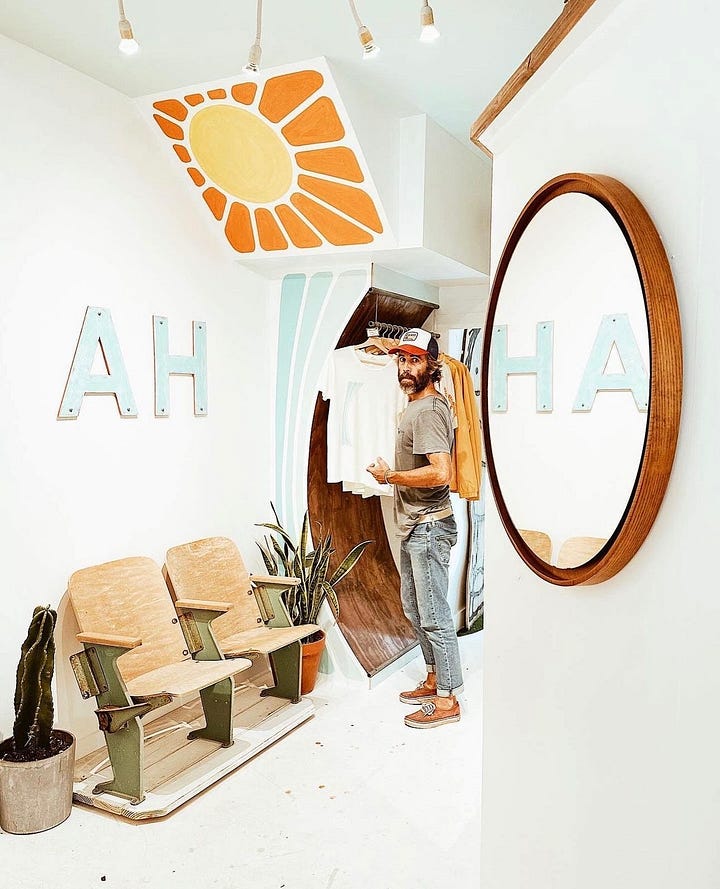
Can you talk about your life leading up to the founding of COAST Projects? I read that you came to Key West after graduating from Boston College and ended up working as a boat captain and shipbuilder.
I came down here after college twenty-something years ago. Up until that point, my life was pretty normal. It’s not abnormal now — but nothing stood out. I originally came down senior year (at Boston College) during spring break. Five of us drove down in a Jeep. After a few days at the bars and on the beach, I remember saying, “We should move down here when we graduate” and everyone said, “yea, great idea!” Then, six months later, I checked in with my buddies, “Okay, so we’re moving to Key West, right?” Everyone said no. It was, “I’m going to law school” or “I got a job” or “My parents won’t let me” or whatever. I graduated, didn’t know what I wanted to do, and thought maybe 1 or 2 of the guys would still be up for it. I ended up finding some other buddies to come down with me. I got down here in the early 2000s and started working on a boat. I thought I’d be here for six months, and it turned into, well, more than 20 years.
I decided that if I was going to be down here, I’d rather drive the boat than clean it. So I got my captain’s license. It was a good job, but ultimately it got a bit monotonous, and the days were long. One of the companies I was sailing for was also building their own charter boats. That was the first time I started to realize that I would rather be making something than have someone be my boss. Don’t get me wrong, as a captain — when you’re out there at sea you are the boss — but when you come back to the dock you are usually listening to somebody else. When I started boat building, I worked with a small crew and had a project leader, but I would work on smaller projects on my own. I loved the idea of making something and looking at it at the end of the day. During that time, I got my own studio. It was a place where I could have my tools and make stuff. That's when I taught myself how to screenprint. There’s a whole other chapter that starts there as well.
Let’s flash forward to the founding of COAST. What’s the most honest way you would describe what it was like to get COAST up and running in those early years?
There was a five-year chapter in between the boat building and COAST. That was basically when I became a father and lived in Copenhagen. I went to Copenhagen in 2008. It was a restart — a totally new chapter. I couldn’t drive boats, and I didn’t know what I was going to do for work. I was surrounded by this design culture which was really eye-opening to me. I had a workspace where I was making skateboards. After five years, I was ready to go back to the States. Copenhagen is an amazing city, but I wasn’t fulfilled other than having kids. Professionally I was going nowhere. There wasn’t a place for someone who wasn’t Danish to make their way. We moved back to Key West, but I took what I learned in Copenhagen about the impact of design, branding, and attention to detail with me. I decided that I wanted a workspace when I got back around 2012-2013. I went to go and see if my old studio was still available. I went there, and they were literally hitting it with a wrecking ball that day. I realized that a lot had changed on the island, so I started driving around Stock Island, which is the industrial section of Key West. I saw this old fishing shack on a decent-sized piece of land that had a “for rent” sign. I called the number and realized that the cost was way more than I was willing to spend. I really wanted to make it work so I found a few people who would split it up with me.
COAST started out as an artist collective. It was a handful of people who were chipping in for rent on this cool spot, but there wasn’t really any direction. I was inspired by Danish design culture and simplicity and felt like the spot needed a name. I decided to call it COAST and told people we could mess around and do projects. Technically the company is called COAST Projects. The beginning was accidental. It was me looking for a workspace, not being able to find one, finding one that was too big, and then just being like, “How can I make this work because I really want this space?” Then it was an artist collective because that was the only way to make it work financially. Then we got the space and started to think of things we could do there. At the time in Key West, there was lots of live music but no ticketed live shows. You could go to any bar and see live music, but there weren't touring bands coming down. We built a stage and decided to see if we could get some bands to come down. People thought we were crazy. We built a stage, and I had no idea what I was doing or where to begin, but we were the only people in town doing it. The space was big enough where we could get a few hundred people there, assuming we got a decent artist or band to come down. That’s how the concerts started. Moving alongside that, I had started screen printing. We made one t-shirt — the original “Coast Live By It” — which was just a uniform for people in the artist collective. People saw us wearing them so we made more.
It’s so hard to look back and understand how it all happened because it really was organic. There were no decisions. We had the space. We could do whatever we wanted, so we just messed around and did that. There wasn’t too much risk because we were spreading out the costs.


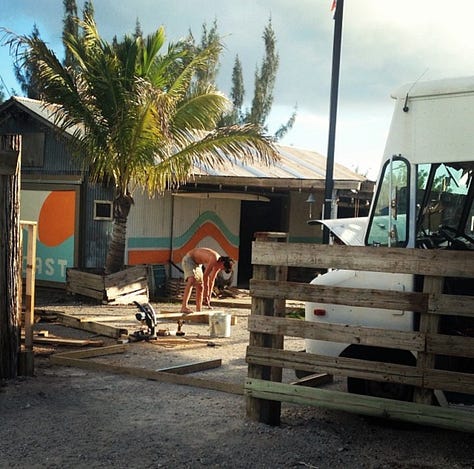
How did it evolve over time? So many businesses go through evolutions and expansions (and certainly covid forced almost everyone in that direction). What was it like for you later on as the business changed?
We still produce live music shows today, but I no longer have a venue. Everything has been a slow evolution. There are things we used to do that we don’t do anymore. Live music has changed a bit because we went from a venue and hosting people to now renting theaters and bringing bands down.
As far as how things have changed, originally we were out on Stock Island, where there were a bunch of studios on the rough edge of town. I think early on we thought we could draw people out there and it would be a retail spot. A month in we realized that wasn’t happening. There was also a period of time when I was selling Coast shirts around town at other retail shops, and there was a big push to take the brand national. There was a whole chapter where that was a focus. I really hated that chapter. Competing with other brands was not at all what I wanted to do. People would say, “Oh, you can be like this brand.” I would say, “You can’t inspire me any less than trying to compare Coast to something else.” To tell me that I could be like somebody else was the least inspirational thing for me. It was the exact opposite of what I wanted to do. The wholesaling of shirts and apparel was a focus for a year or two, we went to a surf expo, and even did some sales road trips. Eventually, I just realized I didn’t want to go down that path and was happy being a local, independent studio and shop that didn’t have to answer to anyone else.
Around that time, I found a spot downtown. I’d decided not to do the national wholesale thing, but I wanted to have a better retail location in town. In 2016/2017, I found a spot in the Old retail district — more specifically the neighborhood called Bahama Village. During that period we had the “factory” on Stock Island and then “The Coast Outpost” where you could buy everything. For 2-3 years I kept up with two locations, but started going out to Stock Island less and less. It was a combination of factors - I had to pick kids up from school, it was easier to be in town, and I was busy at the shop. I eventually decided to get rid of the Stock Island location. That was the closing of a chapter because a lot of people really identified with the Coast concerts and chaotic stuff we had created out on Stock Island. I think a lot of people were bummed out but, for me, that area out on Stock Island represented a five-year period where the stars aligned. When we first got the space, we could do and did do whatever we wanted, to the point where I was surprised that people weren’t hurt or arrested. We somehow managed to get away with all of that for five years, but it was only going to take one thing for us to go down in flames. We got out of there before we had to deal with any big issues. A lot of people would say, “Oh what a bummer that you’re leaving” and I’d think, “No. it’s good. We’re leaving on a high note.”
A lot of artists saw what we did out there and moved to Stock Island as we were leaving. Within two years, they were all gone because of how much it had changed. We ended up downtown. If we wanted to do our live music shows, we just teamed up with venues. The shows became more straightforward - rent a venue, bring in a sound guy, and the band performs. It was a bit more of what a band was expecting. During the early shows at Stock Island, a legitimate tour bus would show up with a huge trailer, having just played a big show in Miami, and now they were performing in an old boatyard. It worked because the artists we were getting were cool with it. Again, that wasn’t always going to work. We’ve now been in this location (The Coast Outpost in Bahama Village) exclusively for the past 5-6 years. It’s been a slow transformation. The pandemic created some uncertainty. Over the past couple of years, there has been a slow expansion of the space. One side of the shop is my studio, the other side downstairs is a gallery and retail shop, and the front porch is additional retail space. I live upstairs with my two kids.
It sounds like an amazing space. One thing I’m picking up from you is being comfortable with the unknown and uncertainty, and trusting that you will listen to your gut and figure it out. If that resonates, what do you attribute that to? What have you learned about being comfortable with uncertainty?
I think a big factor that helps is that I’ve never done anything that caught on where I was making a ton of money. Because of that, I’ve learned to live on the fringe. There’s not that much to lose in a sense. I can pivot and try a new idea. We’ve been around for a long time because we’ve been able to pivot and adapt and slowly evolve. Nothing has been a huge success. What I’m always trying to do is find the next thing that’s cool. My timing is always off and a little bit too early. Someone will come in 2-3 years later, do the same thing, and it takes off. That’s fine. That’s my role - to constantly find things that are new and different. Nothing has been such a big success that it would be hard to walk away from. I’m constantly trying new things. It would be nice to find some big success and something that really works and would set me up. Because I don’t have that thing, I’m always willing to keep trying. Even now, most of my interest is in painting. Talk about something that is a complete shot in the dark. Who knows if this will work? Making art is a complete unknown. I have other things I do as a graphic designer, and I also screenprint for other companies around town. There are things that I can do to bring money in on a monthly basis, but those things will never scale the way that I’m doing them. I don’t want to be a screenprinter. I’ll do it, but it’s not what I want to do. I’m painting a lot and I love that. Maybe that will be the thing. I have no idea. Coast Projects - the whole venture and vision is that it’s a series of projects. You shouldn’t get too attached to anything. It’s all one big project. Life is one big project.
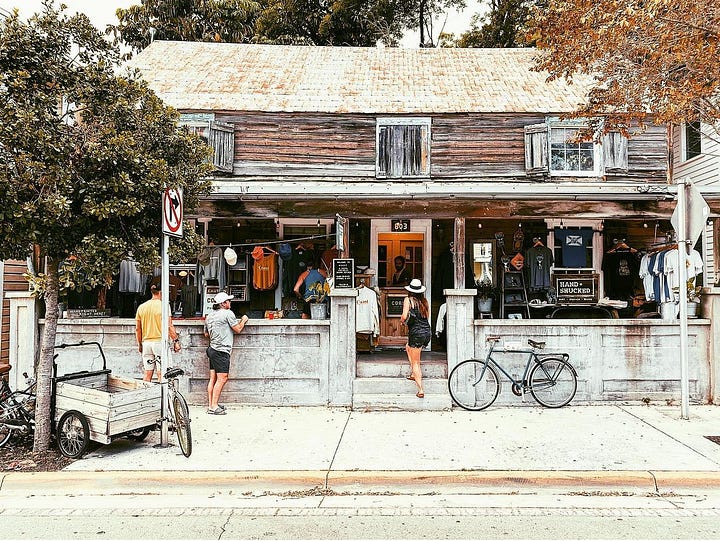
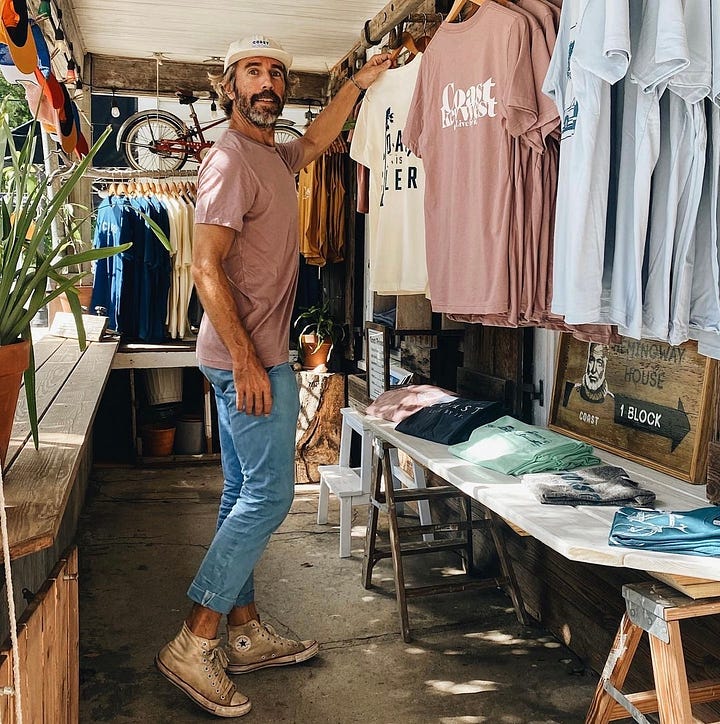
I want to go back to you becoming more comfortable with the title of artist, something you’ve written about on your site. What got you there?
I used to hate that term because it seemed overused, especially down here in Key West. There are a lot of people down here who are open-minded and free-spirited. So many times I would be on the edge of a conversation or see someone who was labeled as an artist or whatever and I would be like, “Man, what’s the criteria for being an artist if this person is an artist?” I”m generally not cynical like that, but it is a little bothersome.
I also had a big issue with being a graphic designer because I didn’t go to school for art or graphic design. And I didn’t want to tick people off who did. Anyways, as it goes I got more comfortable using the label over time because I had created a pretty decent body of work. It was all over the place. Poster art, apparel, street art, murals, sign painting, writing. I have this portfolio of creations, but it was so all over the place. I think sometimes the follow-up question when you tell someone you’re an artist is, “What do you do?” or “What’s your medium?” They expect you to say that you are a painter or sculptor. Because my art was so varied and all over the place, I had to answer two hard questions in a row. Everything I tend to do starts with an impulse and then a slow evolution to get to a point where I make sure I like it enough to keep doing it. There was a long period of time when I refused the artist label. Then slowly I got more comfortable because I had the work to justify the label.
If you put art into the world, you are an artist, so to speak.
Yea, over the past few years, I have done more art for the sake of art rather than to sell in the shop. I used to spend a lot of late nights doing stuff to sell in the shop. Over the past few years, I’ve found myself staying up late to make art that maybe someone will never see. There was one point where my son was applying to prep school and had to answer a question about “father’s occupation.” He put “artist” and that was the first time I thought, “Huh. That’s how he sees me.” I think even a few years earlier, it would have been a different answer. Maybe it was a point in time where people close to me realized that was what I was now, as opposed to a business owner or music producer or whatever.
I read an interview of yours online where you talked about the importance of taking time to recharge and how that can go against the impulse to keep working. A lot of entrepreneurial and creative people find it hard to give themselves that permission to take a step back. What’s the advice you have for them?
When I consider myself as a business owner, it’s harder to prioritize time to relax because it feels like your goal is something else. The goal is to make the business stronger or something like that. Once I became more comfortable over the past few years of easing into an artist role, it became easier to prioritize relaxing. I think that’s because the creative mind requires it more, and you work in a different pattern. A businessperson is getting something done for tomorrow or a deadline, whereas when I’m making art the inspiration comes at different times. If I’m not inspired, then I need to take a break because it’s not going to come by pushing harder. A lot of times, I’ll go to the beach for a bit or take a nap or decide to go to bed early. Or, like last night, I stayed up until 4:30 in the morning painting because I felt like it. I wasn’t trying to get a painting done, I was just having fun painting. If I was up at 4:30 in the morning as a business person, it was because I was stressed about something. Being up at 4:30 as an artist isn’t stressful, it’s the easiest and most fun time to work.
Last question: What’s next for you?
The painting feels good right now. I’m trying to get feedback from people close to me. I want to know what’s working for other people, not so I can make paintings that please people, but because sometimes it’s hard to know if what you’re doing is interesting to something else. At the end of the day it would be cool to make money from painting because I’m enjoying it so much. Giving myself more time to make art in hopes that it catches on somewhere. I’m also at a different stage. My son goes to prep school in New England and loves it. My daughter is in middle school. They don’t need me as much. I have more time. It’s natural for me to be messing around with art now because the kids are at an age where I can do that. What’s next is pushing forward with the role of artist and seeing where that leads.




